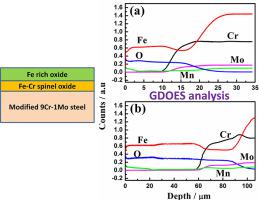当前位置:
X-MOL 学术
›
Spectrochim. Acta B. At. Spectrosc.
›
论文详情
Our official English website, www.x-mol.net, welcomes your
feedback! (Note: you will need to create a separate account there.)
Atmospheric air oxidation of 9Cr-1Mo steel: Depth profiling of oxide layers using glow discharge optical emission spectrometry
Spectrochimica Acta Part B: Atomic Spectroscopy ( IF 3.2 ) Pub Date : 2020-10-01 , DOI: 10.1016/j.sab.2020.105973 Ch. Jagadeeswara Rao , S. Ningshen , John Philip
Spectrochimica Acta Part B: Atomic Spectroscopy ( IF 3.2 ) Pub Date : 2020-10-01 , DOI: 10.1016/j.sab.2020.105973 Ch. Jagadeeswara Rao , S. Ningshen , John Philip

|
Abstract Modified 9Cr-1Mo steel is used as a steam generator tube material of fast breeder reactors. Although air oxidation behavior of modified 9Cr-1Mo steel is qualitatively studied, the exact nature of oxide layers formed across the thickness of the film from nanometer to several microns depth is not studied systematically. In this work, the oxide scales formed on modified 9Cr-1Mo steel on air oxidation at 650 °C up to 200 h duration using Glow Discharge Optical Emission Spectrometer (GDOES) with depth profiling, X-ray Diffraction (XRD), Laser Raman Spectroscopy (LRS) and Scanning Electron Microscopy coupled with Energy Dispersive Spectroscopy(SEM-EDS) were investigated. The weight changes increase and did not follow the conventional parabolic kinetics. The top layer of the oxide scales after 25 and 50 h air oxidized samples comprised of MnCr2O4, Cr2O3 and Fe, Cr spinel oxides; however, the oxide scales of 100 and 200 h oxidized samples mainly consist of hematite. GDOES analysis indicated the presence of Fe rich oxides on the top surface of the oxide films in the case of 100 and 200 h oxidized samples. For 25 and 50 h samples, the oxide layer consists of manganese oxides in addition to Cr and Fe spinel oxides. All the samples consist of Fe and Cr spinel oxides at the interface of the oxide and alloy surfaces. SEM analysis indicated the formation and growth of oxides from small crystal and flakey type morphology to fully grown bigger size particles as the oxidation progresses. GDOES technique provided useful insights into the nature of oxide films through the thickness of the film. The intensity depth profiles of the oxide layers obtained by GDOES-DiP (Differential Interferometric Profiling) is complemented by other techniques such as XRD, LRS and SEM-EDS.
中文翻译:

9Cr-1Mo 钢的大气空气氧化:使用辉光放电发射光谱法对氧化层进行深度分析
摘要 改性9Cr-1Mo钢用作快中子增殖堆蒸汽发生器管材。尽管对改性 9Cr-1Mo 钢的空气氧化行为进行了定性研究,但没有系统地研究在薄膜厚度范围内从纳米到几微米深度形成的氧化层的确切性质。在这项工作中,使用具有深度剖析、X 射线衍射 (XRD)、激光拉曼光谱的辉光放电发射光谱仪 (GDOES) 在 650 °C 空气氧化达 200 小时后,在改性 9Cr-1Mo 钢上形成的氧化皮(LRS) 和扫描电子显微镜结合能量色散光谱 (SEM-EDS) 进行了研究。重量变化增加并且不遵循传统的抛物线动力学。由 MnCr2O4、Cr2O3 和 Fe、Cr 尖晶石氧化物组成的样品在 25 和 50 小时空气氧化后的氧化皮顶层;然而,100 和 200 小时氧化样品的氧化皮主要由赤铁矿组成。GDOES 分析表明,在氧化 100 和 200 小时的样品的情况下,氧化膜的顶面上存在富铁氧化物。对于 25 和 50 小时的样品,除了 Cr 和 Fe 尖晶石氧化物之外,氧化层还由锰氧化物组成。所有样品均由氧化物和合金表面界面处的 Fe 和 Cr 尖晶石氧化物组成。SEM 分析表明,随着氧化的进行,氧化物从小晶体和片状形态到完全生长的更大尺寸颗粒的形成和生长。GDOES 技术通过薄膜的厚度提供了对氧化物薄膜性质的有用见解。
更新日期:2020-10-01
中文翻译:

9Cr-1Mo 钢的大气空气氧化:使用辉光放电发射光谱法对氧化层进行深度分析
摘要 改性9Cr-1Mo钢用作快中子增殖堆蒸汽发生器管材。尽管对改性 9Cr-1Mo 钢的空气氧化行为进行了定性研究,但没有系统地研究在薄膜厚度范围内从纳米到几微米深度形成的氧化层的确切性质。在这项工作中,使用具有深度剖析、X 射线衍射 (XRD)、激光拉曼光谱的辉光放电发射光谱仪 (GDOES) 在 650 °C 空气氧化达 200 小时后,在改性 9Cr-1Mo 钢上形成的氧化皮(LRS) 和扫描电子显微镜结合能量色散光谱 (SEM-EDS) 进行了研究。重量变化增加并且不遵循传统的抛物线动力学。由 MnCr2O4、Cr2O3 和 Fe、Cr 尖晶石氧化物组成的样品在 25 和 50 小时空气氧化后的氧化皮顶层;然而,100 和 200 小时氧化样品的氧化皮主要由赤铁矿组成。GDOES 分析表明,在氧化 100 和 200 小时的样品的情况下,氧化膜的顶面上存在富铁氧化物。对于 25 和 50 小时的样品,除了 Cr 和 Fe 尖晶石氧化物之外,氧化层还由锰氧化物组成。所有样品均由氧化物和合金表面界面处的 Fe 和 Cr 尖晶石氧化物组成。SEM 分析表明,随着氧化的进行,氧化物从小晶体和片状形态到完全生长的更大尺寸颗粒的形成和生长。GDOES 技术通过薄膜的厚度提供了对氧化物薄膜性质的有用见解。







































 京公网安备 11010802027423号
京公网安备 11010802027423号